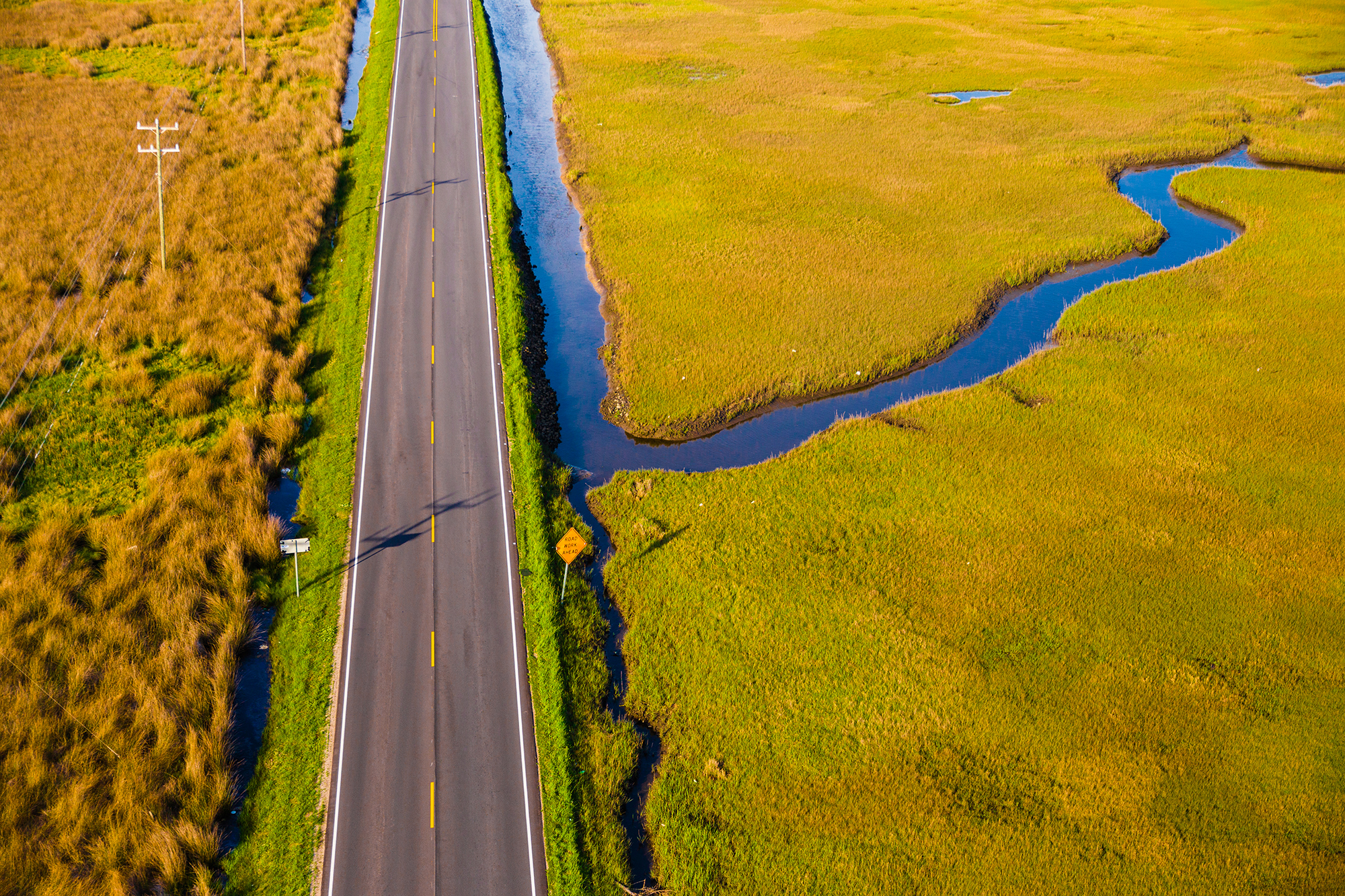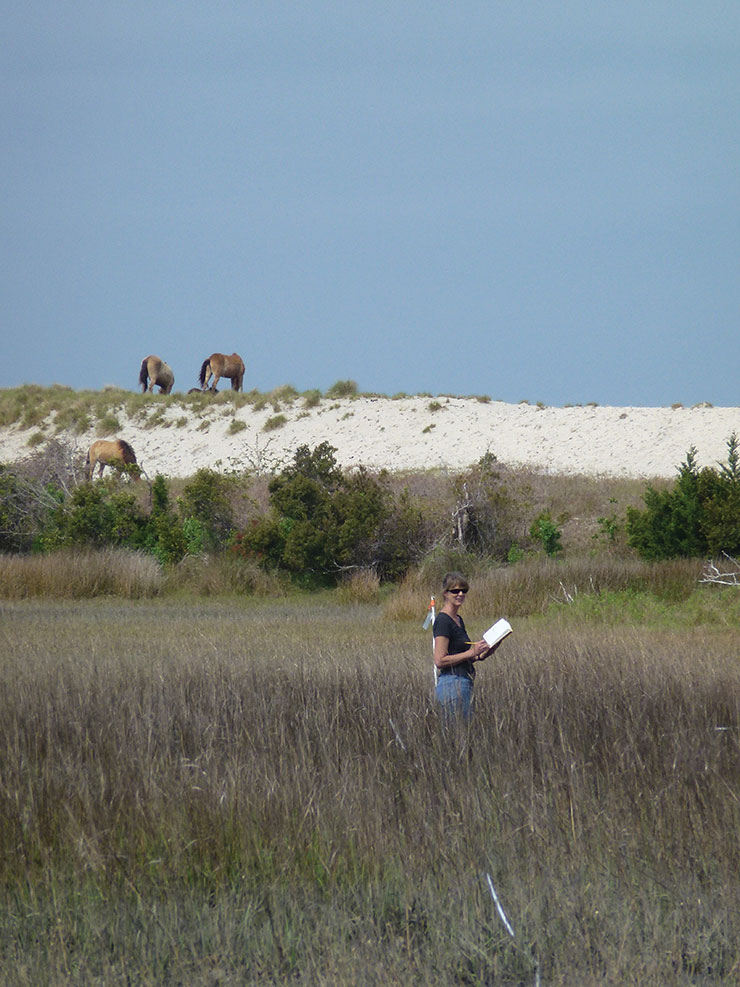NATURALIST’S NOTEBOOK: Dinosaurs in the Rivers?

A prehistoric species, Atlantic sturgeon were a common menu item along the East Coast in the 19th century. However, Atlantic sturgeon are making news these days for placement on a different list: the federal endangered species list.
These fish date back 120 million years and even have dinosaur-like armor from five rows of bony plates, or scutes. The plates provide camouflage and protection from predators for the bottom-dwelling fish that can be 10 feet long and weigh 500 pounds.
“They are really dinosaur-like in the way that they behave,” says Mary Moser. In the 1990s, the N.C. Fishery Resource Grant Program, administered by North Carolina Sea Grant, funded some of her sturgeon research. She is still considered an expert on its habitats in the state.
“It always impresses me that they aren’t like other fish that get so frantic and panic when you handle them. They basically just wait for you to do whatever you are going to do to them. Then you will put them back into the water and they will slowly swim away,” she continues.
Sturgeon are anadromous fish. They migrate into the freshwater coastal rivers to spawn but spend the majority of their lifetime in the sounds and ocean. In North Carolina, adult and juvenile Atlantic sturgeon can be found in the Roanoke, Chowan, Tar, Neuse and Cape Fear rivers during the spawning season.
“Part of the reason why North Carolina has always been a haven for Atlantic sturgeon is that North Carolina has such an extensive estuary system where Atlantic sturgeon thrive,” says Moser, now a National Marine Fisheries Service biologist.
With a life span of up to 60 years, their age of maturation, when they are ready to spawn, is much greater than other fish species — about eight to 10 years for males and up to 20 years for females.
There are few predators for the species due to their protective covering and massive size. The main threats to Atlantic sturgeon are from human activity, such as boat strikes in coastal rivers. Poor water quality and habitat alteration or destruction also are leading issues.
GARBAGE TO GOLD
Sturgeon, Acipenser oxyrinchus, range up and down the East Coast and are broken into five distinct population segments. The National Marine Fisheries Service categorizes the different populations based on genetically unique differences, explains Michael Loeffler, N.C. Division of Marine Fisheries specialist on Atlantic sturgeon.
The Carolina population was officially listed under the Endangered Species Act on April 6, 2012. This distinct population segment stretches from the Albemarle Sound southward to the Charleston Harbor in South Carolina, with accounts of sightings spanning centuries.
Writing about North Carolina sturgeon in 1709, British explorer and naturalist John Lawson describes, “Of sturgeon we have plenty, all the fresh parts of our rivers being well stored therewith. The Indians upon and towards the heads and falls of our rivers, strike a great many of these, and eat them; yet the Indians near the salt-waters will not eat them. I have seen an Indian strike one of these fish, seven foot long, and leave him on the sands to be eaten by the gulls. In May, they run up towards the heads of the rivers, where you see several hundreds of them in one day. The Indians have another way to take them, which is by nets at the end of a pole. The bones of these fish make good nutmeg-graters.”
In the late 1800s, fishermen began commercially fishing the abundant Atlantic sturgeon species. Dare County was known as a market hub.
In 1907, Hugh M. Smith, author of The Fishes of North Carolina, described the changes of the 1880s.
“Within a comparatively few years the fish, formerly regarded as of little value, has come into use on account of its eggs, which are made into caviar, and also on account of its flesh, which is now highly regarded and brings a good price.”
Loeffler adds that during those years, “In some areas, the eggs could be sold for a couple thousand dollars an ounce.”
But the economic lure for the large North Carolina commercial fishing industry of Atlantic sturgeon drastically diminished the population, Smith noted. “It is incumbent on the state to take prompt and radical measures to prevent the further diminution in the supply of this excellent fish, and to restore it to something like its original abundance, if this is now possible.”
SPAWNING QUANDRIES
Those comments ring true today. “Sturgeon are their own worst enemy,” adds Joe Hightower, North Carolina State University fisheries biologist. “They take a long time to reproduce. Females are said to skip spawn, which means they only spawn every three to five years. They grow slowly and they are also a very predictable fish in that they come into the rivers every time they are going to spawn.”
In his 1907 work that was Volume II of the North Carolina Geological and Economic Survey, Smith mentions that Atlantic sturgeon would move into the rivers to spawn in the spring. However, current research suggests a fall spawning period, Loeffler explains.
Moser describes them as a “boom and bust” species. “They spawn multiple times in their lifetime and they live for a very long time, so they may have a lot of spawning events that don’t produce very many juveniles. But if everything lines up and they have a really good spawning event, then that group of sturgeon will carry the population for a really long time,” she explains.

Many variables have to be in place for Atlantic sturgeon to have a large spawning season: water quality, flow and temperature; oxygen levels; males and females on the spawning grounds at the same time; and rock bedding on which the eggs may adhere.
“If everything works out, then they will have a big spawning event and you can see it in the catch statistics, where the sturgeon in the population will be of a similar age,” says Moser, who now works in Washington, but notes her focus dates back to her work in North Carolina.
“They are very primitive and they have a really unique life history so now I am hooked on sturgeon and I have been working on sturgeon ever since,” she states. Her initial research focused on the distribution and movements of shortnose and Atlantic sturgeon.
“Particularly in the Cape Fear River, it was some of the first work that had really delved into what their movements and distribution were in the estuarine and riverine areas,” she adds.
A state moratorium went into effect in 1991, limiting commercial fishing of Atlantic sturgeon in North Carolina waters.
“North Carolina felt that it was important to protect Atlantic sturgeon but didn’t know exactly how many Atlantic sturgeon we had,” Loeffler continues. “The effects from that moratorium are just about now being felt in the population. So we should start to see those protected generation classes come back to the Roanoke or the Cape Fear for the first time to reproduce because of the age of maturity.”
INNOVATIVE RESEARCH
Numerous studies funded by Sea Grant partners are ongoing to determine the population size of the Carolina Atlantic sturgeon. Population research involves surgically implanting transmitters into Atlantic sturgeon. Each transmitter has a unique signal and can be picked up by receivers up and down the East Coast.
“By putting transmitters in the fish, we can see where they go, where they spawn, whether dams are limiting their movement, where they go relative to where commercial fishing is occurring and how much interaction there is with the areas where commercial fishing occurs,” explains Hightower, who also is a researcher for the U.S. Geological Survey at the N.C. Cooperative Fish and Wildlife Research Unit.
However this method has proved difficult because sturgeon are evasive. Atlantic sturgeon typically do not bite fishing lures and require a heavy monofilament gill net. “If you don’t fish a sufficient size gill net or have enough monofilament twine, then you are not going to capture an adult sturgeon that weighs 200 to 300 pounds,” Loeffler notes. “They are just going to swim through that gear.”
Atlantic sturgeon can be found in deep holes and turbid water in rivers and estuaries. “They are generally under the radar. Unless someone is specifically going looking for them, they can be present in a river and you would not know it,” Hightower says. “Our research at North Carolina State University involves trying to figure out how many Atlantic sturgeon there are, which rivers they are in and their distribution,” he adds. “We are trying to come up with better ways to assess the population.”
Doctoral candidate Jared Flowers, advised by Hightower, is using methods other than netting and tagging. Side-scan sonar can measure a river’s Atlantic sturgeon population without causing potential stress or harm to the fish. The scientific-grade sonar provides an acoustic shadow that gives a high-resolution image of the river or estuary floor and any bottom-dwelling fish.
“With the acoustic shadow, you can see the shape and the position of the fins and can say with confidence ‘That’s a sturgeon.’ And then you can also measure it,” Hightower says.
Flowers and Hightower have used this new research method in a study of three rivers in North Carolina and three rivers in South Carolina. Preliminary results show populations of sturgeon in the Roanoke and Cape Fear rivers, but the state’s populations don’t appear to be as large as those in South Carolina.
Flowers also added a webcam to the research study. This allowed him to record the surface of the water to observe jumpers. “Sturgeon jumping is pretty common,” Moser explains, describing juveniles in the Cape Fear River that would skip along the surface and spy hop, “where they will look out of the water or breech at the surface.”
Researchers are unsure of why sturgeon jump. “How they slap down on the water might create a form of communication,” Moser speculates, citing a paper she has read. “Other people have thought that it is for buoyancy regulation or getting rid of parasites.” Regardless, they are fascinating creatures. “As researchers, we always joke about the charismatic megafauna that people get excited about, like tigers or dolphins,” Hightower notes. “I think sturgeon are in that category. They are not cute or cuddly but they are really interesting.”
ON THE SOUND
Jack Spruill grew up on the Albemarle Sound, near the historic fishing town of Mackeys. Many generations of his family were commercial fishermen.
Fish houses lined the shore of Mackeys during the fisheries boom from the early 1900s to the 1940s.
Fishermen would set out gill nets and pound nets during spring spawning to catch herring, shad, white perch and striped bass, more commonly called rockfish. Atlantic and shortnose sturgeon were bycatch.
“My grandfather and uncles would catch the occasional sturgeon in their pound and gill nets while fishing out of Mackeys,” Spruill recalls. “The largest was a 585-pounder my uncle caught fishing in the mid 1940s.” Nets were made of cotton and rope and were not meant to contain sturgeon. “To catch a sturgeon back then, you had to have a lot of luck going for you,” he continues.
“My Uncle Marshall told me that when a large sturgeon got into one of the gill nets, the hope was that the sturgeon would wallow laterally to the net and wrap itself in both the top and bottom ropes of the net, otherwise the sturgeon would usually break free of the net and swim away.”
In Mackeys, smaller sturgeon that were about 3 feet in length — nicknamed pelicans by elder fishermen — were desired for eating.
Cousin Bob Spruill explains that sturgeon were not a common catch, but “when a sturgeon was caught, it received a lot of attention.”
This article was published in the Spring 2013 issue of Coastwatch.
For contact information and reprint requests, visit ncseagrant.ncsu.edu/coastwatch/contact/.
- Categories:


